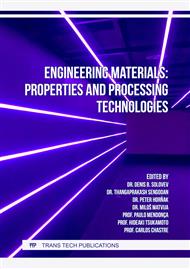[1]
B.G. Pechenyj, V.L. Kurbatov, V.P. Losev, On the mechanism of bitumen aging and methods of their testing, University Science. 2(8) (2019) 28-32.
Google Scholar
[2]
Ju.G. Borisenko, T.S. Savchenko, Analysis and ways of optimizing methods for determining the durability of road asphalt concrete, scientific journal. Engineering systems and structures. 4-3(17) (2014) 66-71.
Google Scholar
[3]
J.V. Kotljarskij, O.A. Voejko, Durability of road asphalt concrete pavements and factors contributing to the destruction of the structure of asphalt concrete during operation, Moscow. Tehpoligrafcentr, 2007, p.136.
Google Scholar
[4]
V.E. Kopylov, O.N. Burenina, Physical and Mechanical Properties of Asphalt Concrete Modified with Activated Mineral Powders. Materials Science and Engineering. Vol. 753 (2020) 1-6
DOI: 10.1088/1757-899X/753/2/022037
Google Scholar
[5]
O.A. Ammosova, i dr., Modified polymer and composite materials for northern conditions, otv. red. S.N. Popov, Novosibirsk: Publisher SO RAN, 2017, p.217.
Google Scholar
[6]
V.E. Kopylov, O.N. Burenina, Influence of Oil Sludge on Properties of Asphalt Concretes Used in Regions of the Far North, Materials Science Forum. Vol. 945 (2019) 158-162
DOI: 10.4028/www.scientific.net/MSF.945.158
Google Scholar
[7]
V.E. Kopylov, O.N. Burenina, The stabilizing additive from natural zeolite for stone mastic asphalt, Materials Science & Engineering. Vol. 753 (2020) 1-6
DOI: 10.1088/1757-899x/753/4/042090
Google Scholar
[8]
GOST 8267-93 Crushed stone and gravel from dense rocks for construction work, Specifications, Moscow. Standartinform, 2008, p.18.
Google Scholar
[9]
GOST 31424-2010 Non-metallic building materials from screenings of crushing of dense rocks in the production of crushed stone, Technical conditions, Moscow. Standartinform, 2011, p.20.
Google Scholar
[10]
GOST 22245-90 Oil road viscous bitumens, Technical conditions, Moscow. IPK Standards Publishing House, 2005, p.9.
Google Scholar
[11]
Measurement technique № 222.0119/01.00258/2014, Determination of the group composition of chloroform bitumoids of rocks, soils and stripped oils by the gravimetric method, 2014, p.15.
Google Scholar
[12]
GOST 12801-98 Materials based on organic binders for road and airfield construction, Test methods (with Amendment H 1), Moscow. GUP CPP, 1999, p.53.
Google Scholar
[13]
V.E. Kopylov, L.A. Nikolaeva, Assessment of Corrosion Resistance of Asphalt Concrete with Mineral Powders from Local Raw Materials, Materials Science & Engineering. Vol. 1079, chapter 2 (2021)
DOI: 10.1088/1757-899X/1079/3/032021
Google Scholar
[14]
L.A. Urhanova, N.I. Shestakov, S.L. Bujantuev i dr., The use of carbon nonmaterial's to obtain an effective road-building composite, Bulletin of the East Siberian State University of Technology and Management.. 6(51) (2014) 67-72.
Google Scholar
[15]
I.M. Grushko, I.V. Korolev, Road construction materials, Moscow. Transport, 1991, p.357.
Google Scholar
[16]
Je-Him, Electronic resource. URL: http://studere.ru/2010/10/oglasite-ves-spisok-pozhalujsta/
Google Scholar
[17]
R.D. Salahov, L.R. Sabirov, Experimental study of the aging of modified asphalt concrete with limestone crushing waste, Modern technologies in construction. Theory and practice. T. 2 (2018) 325-330.
Google Scholar
[18]
V.J. Ilivanov, M.G. Salihov, Investigation of the durability of modified crushed stone-mastic asphalt concrete under the action of an aggressive environment, Bulletin of the Volga State University of Technology, Series: Forest. Nature management. 2(18) (2013) 38-45.
Google Scholar
[19]
M.A. Vysockaja, S.J. Shehovceva, D.A. Kuznecov, Features of the interaction of alternative dispersed porous mineral materials with an organic binder, Bulletin of higher educational institutions. Construction. 4(724) (2019) 35-46.
Google Scholar
[20]
D.A. Kuznecov, B.S. Agamjan, T.R. Baranov, Resistance to cracking during aging of asphalt concrete with porous mineral powders, Bulletin of the Belgorod State Technological University named after. V.G. Shukhova. 6 (2013) 43-45.
Google Scholar
[21]
M.Y. Abdullayeva, K.S. Shikaliyev, Research of influence of mineral filing on the properties of rood – construction bitumen, Theoretical and Applied Science. Vol. 36, 4 (2016) 106-110
DOI: 10.15863/TAS.2016.04.36.15
Google Scholar
[22]
G.J. Drozd, I.I. Bizirka, Adsorption and desorption of bitumen on the surface of mineral materials, Bulletin of Lugansk State University named after Vladimir Dahl. 1 (2016) 202-204.
Google Scholar
[23]
GOST 9128 2013 Asphalt concrete mixtures, polymer asphalt concrete, asphalt concrete, polymer asphalt concrete for highways and airfields, Technical conditions, Moscow. Standartinform, 2019, p.89.
DOI: 10.1520/stp17841s
Google Scholar


